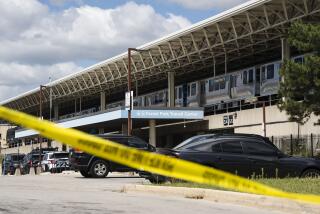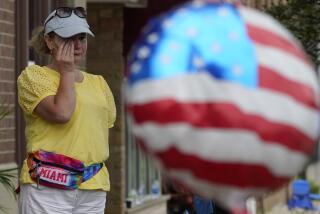8 homicides in 1 day are latest signs of Chicago’s bloody summer
A woman, at left, who identified herself as the mother of the shooting victim, is comforted by another woman at the crime scene in the Bridgeport neighborhood June 10, 2015.
Reporting from Chicago — Diane Limas says the sound of gunfire has become so common outside her house that she’s frequently calling police to complain.
With increasing gang problems to blame, she even makes sure that her adult brother whom she cares for doesn’t leave the home dressed in colors that might draw the wrath of gang-bangers.
“I double-lock my doors,” she said last week. “I tell my brother to stay away from the windows. I’m calling the police every week.”
As summer draws to an unofficial close on Labor Day, the rise in violence plaguing Chicago this year has even spread to unlikely communities such as Albany Park, a laid-back, diverse working-class neighborhood made up of handsome brick bungalows and two-flats.
Through Sept. 3, homicides jumped to nine in the Albany Park police district, up from just two in the year-earlier period, according to data from the Police Department. Shooting incidents have more than doubled to 23 from nine in the district on the city’s northwest side.
In addition, the South Loop’s Central police district didn’t record a single homicide at this point in 2014 but has seen three so far this year.
A bloody end to the summer pushed the rise in homicides to 23% by Thursday, up from a 14% increase as of June 1. On Wednesday alone, eight people were shot to death in homicides, the most in a single day in Chicago in more than 12 years.
For a second consecutive year, shooting incidents are on the rise, to 1,625 so far this year, up more than 17% from 1,384 a year earlier.
Experts say it is difficult to explain what is behind the surge in homicides and shootings in Chicago, but major cities across the country are struggling with similar problems, if not worse. Milwaukee, in particular, has seen homicides soar to 106, up 80% from 59 a year earlier, a Police Department spokesman said Friday. Homicides have risen by about 60% in St. Louis.
In Chicago, gang conflicts have long been fueling much of the gun violence. Police blame battles over turf and reputation for much of the bloodshed.
In an interview, Robert Tracy, the department’s chief of crime control strategies, said that more than ever, petty disagreements and interpersonal conflicts are too often being settled by gunfire.
“We have a very big gang problem in the city of Chicago, and at the same time we have too many people carrying illegal guns without many consequences,” said Tracy, picking up on a favorite theme of Supt. Garry McCarthy, who blames the proliferation of guns and lax gun laws for much of the violence.
Tracy Siska, executive director of the Chicago Justice Project, an independent nonprofit research group, said the reasons for the violence are much broader than policing and gun laws.
“Chicago has an endemic problem with poverty and a high concentration of segregation,” Siska said. “The persistent problems with violence are rooted in poverty, lack of education and lack of opportunities. The city has abandoned some neighborhoods and doesn’t care what happens in some communities.”
Whatever the reasons might be, residents are hearing gunshots and experiencing violence in places where it once was less common.
Maria Elena Sifuentes moved to Albany Park from the Pilsen neighborhood 30 years ago in part to escape street violence and shootings, she said. But now, on her block on Spaulding Avenue the sound of gunfire too often rings out.
“It’s terrifying,” said Sifuentes, 51. “I thought I was over with that part of my life. When you hear about shootings in other places, you think it’s not connected to you. But when it happens right here, it gives you a different outlook. It’s so sad to see kids killing kids.”
Some of the surge in the Albany Park violence comes from an increase in gang activity, said Alderman Carlos Ramirez-Rosa.
Authorities have said a reputed leader of the Simon City Royals gang used some of the winnings from a $25-million verdict for a wrongful murder conviction to recruit new members through intimidation and $50,000 cash bonuses. Last month, Thaddeus Jimenez was arrested on charges he shot a former gang member in the legs in a brazen daylight attack after the victim refused efforts to rejoin the gang.
According to police records, the majority of those killed in the Albany Park police district this year had gang ties.
But when Manuel Arizaga, 34, a married father of a 1-year-old daughter, was fatally shot in the head in July as he left his Irving Park home before sunrise to go to work delivering furniture, the community in northern Chicago rallied together, hosting a meeting to strategize on how to combat the violence.
“For the longest time we’ve had a safe neighborhood, and we want it to remain that way,” said Dennis Puhr, who helped organize the event. Rather than hide in their own homes, Puhr said neighbors have made their presence known, walking about the area and sitting out on their porches to show they, not the troublemakers, are in charge.
“We decided we needed to come together and offer some support to this family,” he said. “We put together a contact list. People are walking a bit more and making an effort to get to know each other. We feel that’s a great deterrent to crime.”
Limas, 70, the Albany Park woman concerned about the increase in shootings in her neighborhood, knows the roots of violence run deep. She believes cuts to mental health services, low wages, school closures and lack of opportunity contribute to a rage that can fuel shootings and killings.
But for now, she just wants peace.
“If we don’t all start thinking about what’s causing the violence, then how will it ever stop?”
Chicago Tribune’s Jeremy Gorner contributed to this report.
Twitter @lollybowean
More to Read
Sign up for Essential California
The most important California stories and recommendations in your inbox every morning.
You may occasionally receive promotional content from the Los Angeles Times.










